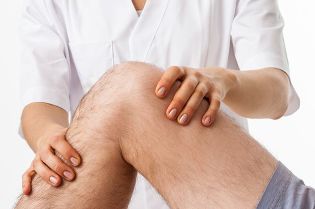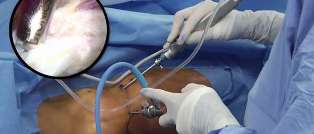What does the diagnosis of "knee osteoarthritis"
It is a disease in which the cartilage is deformed and destroyed. Cartilage is a dense fabric that acts as a shock absorber in any joint, it is necessary for its movement. When the breakdown of cartilage in the joint gradually loses mobility, but if the disease is not treated, then completely ceases to work. However, in the early stages of the disease can be effectively treated with medication and physiotherapy.

By the way, it's About 12% of young people suffer from arthritis, and in retirement, and of this number, over half — about one-quarter of all seniors have been complaining of the symptoms of the disease.
Women suffer from osteoarthritis more often than men.
The risk group also includes active athletes, training, and microtrauma of the cartilage, often leading to restriction of the mobility of the joints at a young age.
There is evidence to suggest that the disease there is a genetic predisposition. If you have a family, there have been instances of this disease, you need to carefully monitor the condition of the joints.
The reasons for the outbreak of the disease
The reasons for the development of osteoarthritis of the knee a lot. They include the following:
- trauma and microtrauma to the joints;
- being overweight is an additional load on the knee joint;
- metabolic disorder in which the cartilage has no essential nutrients;
- unbalanced load during a time of physical work and over-intensive training.
- damage to the circulatory system, in which impaired nutrition of the cartilage tissue;
- prolonged spasms of blood vessels in the legs. The rate of knee OA and symptoms.
Knee osteoarthritis develops gradually.So there are a couple of degrees of this disease.
1. degree. At this stage, the changes are still small, and even can loosely be determined by instrumental surveys. For the development of osteoarthritis of the indicative symptoms, such as slight stiffness in a joint after a long immobility (usually in the morning), and the kingdom of the joint when sudden movements are. Severe pain in the back is usually not there, so people often ignore these signs and go to the doctor only when knee reaches the 2nd stage.
2, the extent of The deformation, x-ray, and noted narrowing of the joint space, and deformity of the cartilage. The signs and symptoms are becoming more pronounced — the patients complain of constant pain, which increases at the beginning of the movement, restriction of mobility, a noticeable stiffness in the morning. A small effort (e.g., lifting) also may cause pain. Sometimes, the skin over the joint becomes red, swells a bit and becomes warm to the touch — this indicates the development of inflammation. With osteoarthritis of the knee 2 the extent of the patients report increased pain when the weather changes or after exposure.
To 3. degree. Severe knee osteoarthritis is characterized by severe pain in all movements, lameness, and sometimes a marked shortening of the leg. The common area is greatly swollen, and in the morning, people just can't get out of bed — sometimes you have to wait half an hour after mobility has been restored. When the 3rd degree osteoarthritis of the knee-joint cartilage significantly thinner, and in some places is completely destroyed, so that the bones touch each other.
To 4. degree. The complete destruction of the cartilage, excruciating pain and immobility — and that's what you'll get, if you ignore the signs of the disease until the last one. The joint space is lost and it starts the deformation of the bone. Diagnosis the first stage of the treatment
If you suspect the disease, you should immediately make an appointment to see the doctor, a podiatrist, who diagnosed her.
The diagnosis of the disease involves laboratory and instrumental methods.
The first one is the General and biochemical blood and urine analysis. These tests help to exclude autoimmune disorders, which lead to the defeat of the joints, in order to determine the presence of inflammation.
Of the instrumental methods of the diagnosis of the disease is most commonly used, simple radiographs in two projections, ultrasound, computed tomography, and magnetic resonance imaging.
Methods for the treatment of osteoarthritis of the knee
Osteoarthritis of the knee were treated, but the prognosis is usually favorable if you start the treatment early as possible on the 1-2 stages of the disease. A lot of the methods of treatment, but a comprehensive treatment provides the desired outcome.
Among the most effective methods to shock wave therapy, traction of the wrist, intra-articular administration of drugs, the toning of the muscles, and the physiotherapy (physical therapy).
Therapy
It helps you to deal only with the symptoms.
Nonsteroidal anti-inflammatory drugs
the reduction of the inflammation and the pain.
chondroprotectors
to stimulate the nutrition of the articular cartilage. As a Supplement is widely used the body fat, and gels, with the analgesic effect, as well as the external funds for the relief of the inflammation and an improvement of the microcirculation of the blood.
UHT
Shock wave therapy — a method by which a therapeutic effect is achieved by the effect of sound waves on tissue in the joint. This is a relatively painless procedure, which, however, allows you to achieve impressive results — for the relief of pain, and to destroy, and to soften the calcium deposits (osteophytes), enhancement of metabolic processes in tissues, normalize blood circulation and relieve swelling, the language of the common people, to "clean up" the joint. The effectiveness of the treatment will reach 90%.
Physical therapy
Therapeutic exercise — it is almost a necessary part of the treatment of osteoarthritis of the knee. kinesitherapy is a specific exercises with a carefully calculated load and the hydrotherapy — exercises that are performed with specialized medical devices. Physical therapy allows you to restore the mobility of joints, improve the flow of blood to the developing and strengthening of the ligaments.
The traction of the wrist
The pulling, or traction to the joints is carried out at a specialist orthopaedic devices. In this method, the stretching of the joint and stretching of the joint space, which results in a reduction of the friction of the articular surfaces and the patient's joint is taken out. The positive effect is observed in 80% of cases.
Intra-articular injections
How to drain excess synovial fluid, and the injection of drugs — anti-inflammatory, analgesic, and improves the flow of blood to the articular cartilage of drugs, and so on.
It is necessary to specify in such a method, such as an injection on your own patient's plasma into the joint capsule of the growth factors contained in the plasma. They speed up recovery and regeneration of damaged articular cartilage. An advantage of PRP is that on its own the plasma is not allergies, this is a safe, bio stimulator of regeneration. 2 to 3 months after a course of PRP, the patients note that the pain and numbness has decreased by about half, and the mobility of the joint improved.
Toning the muscles of the face
The method of treatment is based on stimulating the muscles of the face microcurrents. In the case of an arthrosis of a knee joint is atrophy of the thigh muscles, compromised blood supply. This dramatically increases the load on the joints.
Stimulation helps to strengthen these muscles, and thus to relieve the load on the joint to improve the circulation of the blood, in order to establish a framework for the joint.
Surgery

arthroscopic debridment. The method used for the removal of the common elements of the destroyed cartilage, meniscus part. The operation is performed under video control. The endoprosthesis. If the joint is completely destroyed, it can only be replaced by an artificial. The endoprosthesis resorted to only in the most severe cases, the third or the fourth stage of the disease.
Your new knee will last for 12-15 years. For the timely diagnosis of osteoarthritis of the knee, it is important to not withdraw and do not postpone visit to the doctor or to self-medicate using over-the-counter medications.
The disease developed gradually, but, for some people, one of the first symptoms of the disease and the time to get the can be just the thing after a couple of years — it all depends on the individual. In the majority of cases, an early diagnosis and an holistic approach to the treatment can control the signs and symptoms of arthritis, and the back of the joint.













































